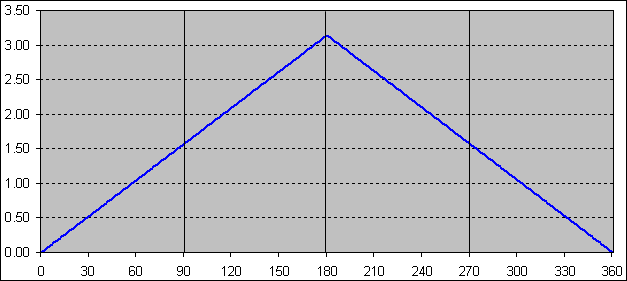Syntax. ACOS(number)
Definition. The arccosine is the angle whose cosine is number.
Arguments
number (required) The cosine of the angle; must be between –1 and 1
Background. Use the ACOS() function to calculate the adjacent angle based on the cosine (see Figure 16-2). The result is a radian measure and has to be converted into degrees with the DEGREES() function. Because each angle occurs two times in a full circle, the value range for an arccosine is restricted:
If the angle is calculated as a radian measure, the value range spans 0 to π (pi).
If the angle is calculated in degrees, the value range spans 0 to 180 degrees.
The arccosine is strictly monotonic decreasing. The values of the arccosine in a coordinate plane create the graph shown in Figure 16-2.
Examples. The following examples illustrate the ACOS() function.
Example 1. A 30-foot ladder leans against a house. The distance between the bottom of the ladder and the wall is 7 feet. What is the angle of incline?
First, you calculate the cosine from the adjacent leg (the distance to the wall) and the hypotenuse (length of the ladder).
The angle is calculated from the cosine:
=DEGREES(ACOS(7/30))
The angle of incline is 76.51º or 76º and 51 minutes. Because the ACOS() function returns a radian measure, you have to convert the result into degrees.
Example 2. The angle resulting from the cosine 0.707106781 could be 45º as well as 315º. Because the range is limited to 0º to 180º, the result is 45º. The corresponding formula looks like this:
=DEGREES(ACOS(0.707106781))
Because the result is a radian measure, you have to convert it by using the DEGREES() function. Here are a few more examples:
=ACOS(0)returns the radian measure1.570796327and a 90º angle.=ACOS(-0.5)returns the radian measure2.094395102and a 120º angle.=ACOS(-1)returns the radian measure3.141592654and a 180º angle.

